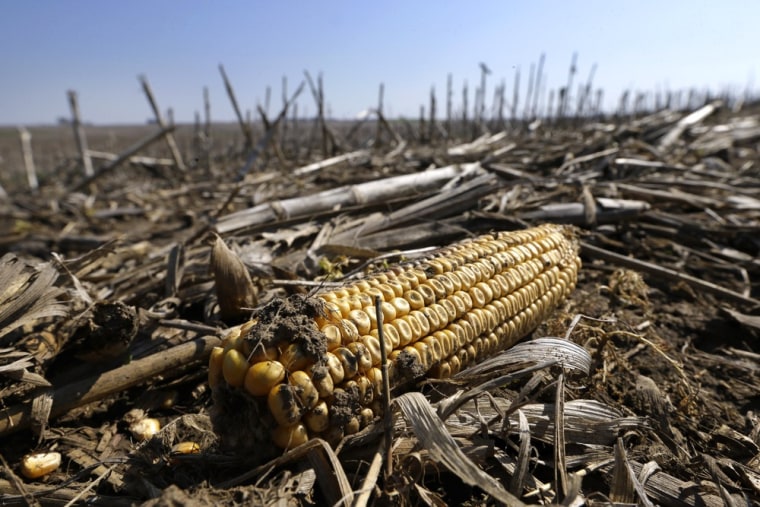
American eaters, let’s talk about the birds and the bees: The U.S. food supply – from chickens injected with arsenic to dying bee colonies – is under unprecedented siege from a blitz of man-made hazards, meaning some of your favorite treats someday may vanish from your plate, experts say.
Warmer and moister air ringing much of the planet – punctuated by droughts in other locales – is threatening the prime ingredients in many daily meals, including the maple syrup on your morning pancakes and the salmon on your evening grill as well as the wine in your glass and the chocolate on your dessert tray, according to four recent studies.
At the same time, an unappetizing bacterial outbreak in Florida citrus droves, largely affecting orange trees, is causing fruit to turn bitter. Elsewhere, unappealing fungi strains are curtailing certain coffee yields and devastating some banana plantations, researchers report.
Now, mix in the atmospheric misfortunes sapping two mainstays of American farming — corn and cows. Heavier than normal spring rains have put the corn crop far behind schedule: Only 28 percent of corn fields have been planted this year compared with 85 percent at this time in 2012, according to the U.S. Department of Agriculture. Meanwhile, drought in the Southeastern plains and a poor hay yield have culled the U.S. cattle and calf herd to its lowest level since 1952, propelling the wholesale price of a USDA cut of choice beef to a new high on May 3 — $201.68 per 100 pounds, eclipsing the old mark of $201.18 from October 2003, the USDA reports.
“We are in the midst of dramatic assault on the security of the food supply,” said Dr. Robert S. Lawrence, director of the Center for a Livable Future, part of the Johns Hopkins Bloomberg School of Public Health. The group promotes ecological research into the nexus of diet, food production, environment and human health.
The primary culprit of all this menu mayhem is climate change, which is choking off certain crops already weakened by both genetic tinkering and chemically based farming, some experts contend.
Agricultural history is, of course, laced with tales of crop-munching bug swarms and dirt-baking droughts, leading to famous regional famines. Paleontologists have even argued that the hanging gardens of ancient Babylon dried up because people messed with that micro-climate by slashing too many trees, over-expanding farm fields and exhausting the water supply, Lawrence said.
“So there are precedents but they’ve all been local and people just abandoned those areas and moved on,” he added. “What’s very sobering about the situation today: This is global and there isn’t any other place to go on this spaceship Earth. We need to regard all of these (examples) as a very powerful motivator to try to work on the carbon emissions, to start pushing that parts per million of carbon dioxide back down.”
Last week, the ratio of carbon dioxide in the atmosphere soared to the highest daily average ever recorded by an air monitor station at Mauna Loa in Hawaii — nearly 400 parts per million (ppm), said John Ewald, a spokesman for the National Oceanic and Atmospheric Association, who called it "an extremely important milestone." When that gauge was installed in 1958, the observatory measured a CO2 concentration of 313 ppm. The number means there were 313 molecules of carbon dioxide in the air for every 1 million molecules of air.
“That warmer and more moist air (caused by the CO2) creates the conditions that certain pathogens thrive on,” Lawrence said. “That’s the dilemma with things like the coffee fungi and some of the problems with citrus.”
The world’s collective appetite also is growing as populations rise, leading large, commercial growers and exporters to ship more food internationally – and allowing certain plant-consuming bacteria, fungi and viruses to “hitchhike half way around the world in a day,” Lawrence added.
Moreover, to help meet the need to feed those extra mouths, industrial agriculture has increasingly turned to “mono-culture” farming to boost harvests. That means using science to alter plants and sewing huge fields – fencepost to fencepost – with single crops.
“For instance, corn plants in the American Midwest are grown closer together and taller than they have been in the past because we’re genetically engineering them to do that,” said Lee Hannah, senior fellow at Conservation International, a global nonprofit that advocates for sustainable policies. “That produces a lot more food. But it also makes that corn more vulnerable to disease, which, if it gets into that mono-culture system, can sweep through it much as a disease will go through a city a lot faster than it does a rural countryside.
“We’re in a situation where the food supply is more vulnerable than it has ever been,” added Hannah, also an adjunct faculty member at the Bren School of Environmental Science & Management at the University of California at Santa Barbara.
Hannah authored a recent study that predicted climate change may shrink California’s wine-growing areas by as much as 70 percent by 2050.
But less wine in our homes could – some conservationists hope – grab the attention of American consumers who can’t otherwise get their heads around shrinking polar ice caps.
“Maybe seeing this impact all this has on our ability to raise the food we depend on will get us to the tipping point of real policy change and real action,” Lawrence said. “I hope so.”